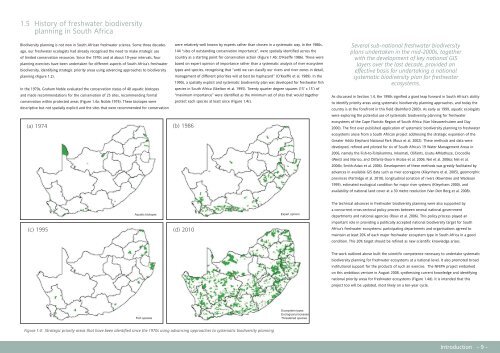NFEPA Atlas 5.3_20111025_FINAL.indd - Biodiversity GIS - SANBI
NFEPA Atlas 5.3_20111025_FINAL.indd - Biodiversity GIS - SANBI
NFEPA Atlas 5.3_20111025_FINAL.indd - Biodiversity GIS - SANBI
- No tags were found...
You also want an ePaper? Increase the reach of your titles
YUMPU automatically turns print PDFs into web optimized ePapers that Google loves.
1.5 History of freshwater biodiversityplanning in South Africa<strong>Biodiversity</strong> planning is not new in South African freshwater science. Some three decadesago, our freshwater ecologists had already recognised the need to make strategic useof limited conservation resources. Since the 1970s and at about 10-year intervals, fourplanning exercises have been undertaken for different aspects of South Africa’s freshwaterbiodiversity, identifying strategic priority areas using advancing approaches to biodiversityplanning (Figure 1.2).In the 1970s, Graham Noble evaluated the conservation status of 40 aquatic biotopesand made recommendations for the conservation of 25 sites, recommending formalconservation within protected areas (Figure 1.4a: Noble 1974). These biotopes weredescriptive but not spatially explicit and the sites that were recommended for conservation(a) 1974were relatively well known by experts rather than chosen in a systematic way. In the 1980s,144 “sites of outstanding conservation importance”, were spatially identified across thecountry as a starting point for conservation action (Figure 1.4b: O’Keeffe 1986). These werebased on expert opinion of importance rather than a systematic analysis of river ecosystemtypes and species, recognising that “until we can classify our rivers and river zones in detail,management of different priorities will at best be haphazard” (O’Keeffe et al. 1989). In the1990s, a spatially explicit and systematic biodiversity plan was developed for freshwater fishspecies in South Africa (Skelton et al. 1995). Twenty quarter degree squares (15’ x 15’) of“maximum importance” were identified as the minimum set of sites that would togetherprotect each species at least once (Figure 1.4c).(b) 1986Several sub-national freshwater biodiversityplans undertaken in the mid-2000s, togetherwith the development of key national <strong>GIS</strong>layers over the last decade, provided aneffective basis for undertaking a nationalsystematic biodiversity plan for freshwaterecosystems.As discussed in Section 1.4, the 1990s signified a giant leap forward in South Africa’s abilityto identify priority areas using systematic biodiversity planning approaches, and today thecountry is at the forefront in this field (Balmford 2003). As early as 1999, aquatic ecologistswere exploring the potential use of systematic biodiversity planning for freshwaterecosystems of the Cape Floristic Region of South Africa (Van Nieuwenhuizen and Day2000). The first ever published application of systematic biodiversity planning to freshwaterecosystems arose from a South African project addressing the strategic expansion of theGreater Addo Elephant National Park (Roux et al. 2002). These methods and data weredeveloped, refined and piloted for six of South Africa’s 19 Water Management Areas in2006, namely the Fish-to-Tsitsikamma, Inkomati, Olifants, Usutu-Mhlathuze, Crocodile(West) and Marico, and Olifants-Doorn (Kotze et al. 2006; Nel et al. 2006a; Nel et al.2006b; Smith-Adao et al. 2006). Development of these methods was greatly facilitated byadvances in available <strong>GIS</strong> data such as river ecoregions (Kleynhans et al. 2005), geomorphicprovinces (Partridge et al. 2010), longitudinal zonation of rivers (Rowntree and Wadeson1999), estimated ecological condition for major river systems (Kleynhans 2000), andavailability of national land cover at a 30 metre resolution (Van Den Berg et al. 2008).(c) 1995Aquatic biotopes(d) 2010Expert opinionThe technical advances in freshwater biodiversity planning were also supported bya concurrent cross-sectoral policy process between several national governmentdepartments and national agencies (Roux et al. 2006). This policy process played animportant role in providing a politically accepted national biodiversity target for SouthAfrica’s freshwater ecosystems: participating departments and organisations agreed tomaintain at least 20% of each major freshwater ecosystem type in South Africa in a goodcondition. This 20% target should be refined as new scientific knowledge arises.The work outlined above built the scientific competence necessary to undertake systematicbiodiversity planning for freshwater ecosystems at a national level. It also promoted broadinstitutional support for the products of such an exercise. The <strong>NFEPA</strong> project embarkedon this ambitious venture in August 2008, synthesising current knowledge and identifyingnational priority areas for freshwater ecosystems (Figure 1.4d). It is intended that thisproject too will be updated, most likely on a ten-year cycle.Fish speciesEcosystem typesEcological processesThreatened speciesFigure 1.4: Strategic priority areas that have been identified since the 1970s using advancing approaches to systematic biodiversity planningIntroduction - 9 -
















